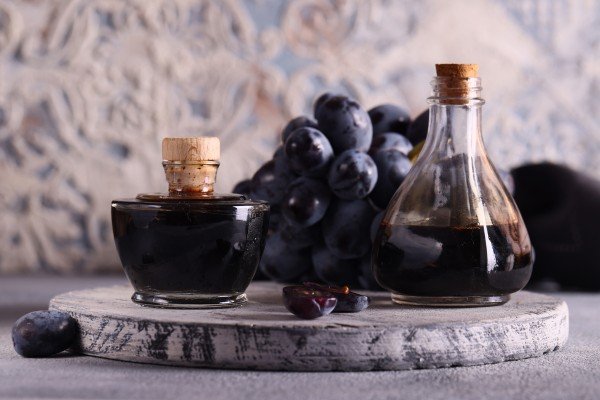The Secret About Italy’s Liquid Gold
Balsamic vinegar is a kitchen must-have across the globe, but let’s be real: they’re not all playing the same flavor game. The Traditional Balsamic Vinegar from Modena, which is also known as Aceto Balsamico Tradizionale, is considered the gold standard, leaving those “Italian-sounding” grocery store versions in the dust.
Corporations use terms or Italian names and imagery to appeal to consumers, yet they don’t adhere to the traditional standards, ingredients, or production methods that genuine Italian products, like Traditional Balsamic Vinegar of Modena, do.
But Modena balsamic vinegar will always have superior flavor, quality, and enjoyability. Why? It’s all about the aging. Authentic balsamic vinegar from Modena spends over ten years in wooden barrels, developing a rich and complex taste profile. Trust us, it’s a game-changer. Once you try true traditional balsamic vinegar, you will never go back.
The Roots of Balsamic Vinegar
Balsamic vinegar’s story kicks off in Modena, Italy, where it’s been the star of the show for centuries. Picture this: way back in the Middle Ages, the crème de la crème of balsamic vinegar, Aceto Balsamico Tradizionale di Modena, was the talk of the town in ducal cellars. Why? Not just for its knockout flavor, but people were convinced it could sort out your digestion troubles and even double as a disinfectant. Talk about a multitasker!
So what makes it stand out from the aisle of wannabes at the supermarket? It’s all in the make. Local grapes get the VIP treatment, cooked down to a must and aged to perfection. This age-old recipe, handed down from generation to generation, shows just how serious Modena is about keeping the balsamic vinegar legacy real and delicious.
How True Balsamic Vinegar is Produced
Traditional balsamic vinegar typically begins in the Italian regions of Modena and Reggio Emilia, in an acetaie, or a type of cellar or attic. It involves a tightly regulated three-step method:
Step One: Grape Selection
Let’s talk grapes. Specifically, the Lambrusco and Trebbiano superstars are picked for their sweet taste. These grapes get a little check-in with a saccharometer – think of it as a sugar detective – to make sure they’re hitting that sweet spot of 15° or higher. Then, they’re cooked traditionally in open containers under a direct heat source for at least 30 minutes until they’re concentrated. Think about it like making grape syrup gold. What about additives or other vinegars? Forget about them. Keeping it pure is the name of the game, ensuring every drop is as authentic as it gets.
Step Two: Natural Fermentation
After the grapes have had their time in the cooking pot, the grape must is put into specially ventilated rooms and prepared for fermentation. Over about three weeks, this environment enables the must to slowly transform into a delicious vinegar. This happens first by yeast bacteria changing sugars into ethanol alcohol. Then, more bacteria takes over to turn the ethanol into a type of acid called acetic acid, which gives the vinegar its characteristic sour component.
Step Three: Aging
After the fermentation step of the vinegar production, now comes the time-consuming part. Aging involves the balsamic vinegar spending its next 12 years being moved into smaller and smaller barrels as it develops. It starts in a large wooden barrel made of local woods like oak, chestnut, and cherry. Each year, some of the concentrate made after evaporating is poured into a successively smaller barrel, and the larger one is topped off with newly fermented vinegar. This setup is known as a “batteria.”
Bottling
Before authentic balsamic vinegar gets the green light to hit the bottle, it has to pass some serious tests to determine its age. But here’s the twist: tracking its age isn’t as straightforward as checking an ID, because this vinegar has been playing musical barrels every year, getting a fresh dash of youth as it goes. Instead, experts taste and grade the vinegar. They grade it as affinato, vecchio, or extra vecchio, indicating varying degrees of maturity, while in Modena, it is distinguished simply as affinato or extra vecchio.
Certification of Authenticity
The certification of authenticity for Modena’s best rated balsamic vinegar is needed to give it access to reach the shelves. Aceto Balsamico Tradizionale di Modena boasts the DOP (Denominazione di Origine Protetta) label, which is like a seal of approval confirming it’s made according to the time-honored methods and strictly within its designated locations. To snag this certification, the vinegar has to impress a panel of experts through intense analytical and sensory tests. This rigorous vetting process is your guarantee that what you’re buying is authentic and top-notch.
Comparing Traditional to Commercial Balsamic Vinegar
Imagine balsamic vinegar from Modena as a gourmet dish at a fancy restaurant, while the commercial kind is more like fast food. The real deal, with its DOP badge, is crafted from pure cooked grape must and aged in wooden barrels for a long, 12-year period. This process produces a rich, layered flavor.
On the other hand, commercial balsamic vinegar is more of a quick fix. It’s a mix of wine vinegar jazzed up with sugars, colorants, and thickeners, and it doesn’t hang around in barrels for long. Sure, it might do the trick in a pinch, but it doesn’t have the same flavor as the genuine Modena.
Culinary Pairings
The best rated balsamic vinegar from Modena is the ultimate flavor booster for a wide range of dishes. Whether you’re tossing it in salads or drizzling it over desserts, its rich, complex taste adds depth to both savory and sweet creations. Here are some of the best ways to use authentic balsamic vinegar to elevate your dishes:
Salads and Vegetables
A drizzle of balsamic vinegar can elevate a simple salad into a gourmet experience. It pairs exceptionally with heavy greens like arugula and spinach, adding a pleasantly sour bite with just a hint of sweetness. For a classic Italian touch, use it with a caprese salad of ripe tomatoes and mozzarella.
Meats
The acidity and sweetness of balsamic vinegar cut through the richness of meats, such as steak or roasted pork, balancing the flavors well. It can be used as a marinade or a finishing glaze to bring out the meat’s savory notes.
Desserts
Surprisingly, traditional balsamic vinegar also fits perfectly in some desserts. A light drizzle over fresh berries or vanilla ice cream introduces a contrast of flavors, joining the sweet with the tangy in an unexpectedly delicious way.
Cheese Pairings
Who doesn’t love a good charcuterie board? Balsamic vinegar’s dense, complex nature complements cheeses’ textures and flavors, from the sharpness of aged Parmigiano-Reggiano to the creaminess of burrata
Try Authentic Modena Balsamic Vinegar
Once you taste authentic Modena balsamic vinegar, there’s no going back. It’s free of additives and has a deep, intense flavor that can’t be beaten. Think of balsamic vinegar like a dark-aged wine – the longer it ages, the more rounded the flavors will be. So, next time you’re in the grocery store, skip the “Italian sounding” balsamic vinegar and go straight for the DOP-certified Modena balsamic vinegar for a delicious experience.

